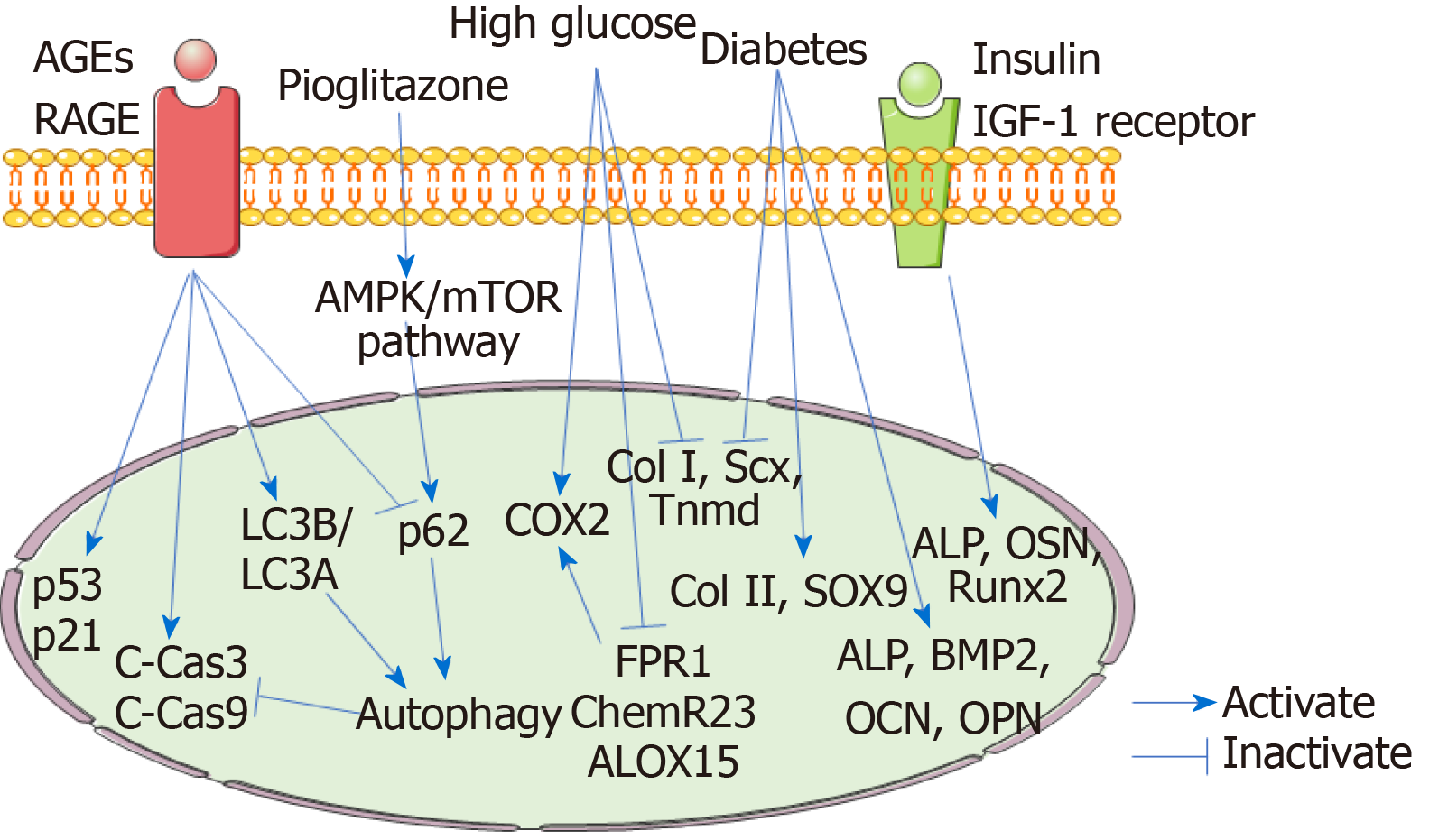Copyright
©The Author(s) 2020.
World J Stem Cells. Nov 26, 2020; 12(11): 1255-1275
Published online Nov 26, 2020. doi: 10.4252/wjsc.v12.i11.1255
Published online Nov 26, 2020. doi: 10.4252/wjsc.v12.i11.1255
Figure 2 Mechanisms involved in the tendon stem/progenitor cells during the process of diabetic tendinopathy.
High glucose inhibits the expression of the tenogenic genes collagen I (Col I), scleraxis (Scx), and tenomodulin (Tnmd) in tendon stem/progenitor cells (TSPCs), indicating the suppressed tenogenic differentiation. Moreover, diabetic TSPCs exhibit increased osteogenic and chondrogenic differentiation abilities and decreased tenogenic differentiation ability with increased expression of osteochondrogenic markers alkaline phosphatase (ALP), bone morphogenetic protein 2, osteocalcin, osteopontin, Col II, and SOX9 and reduced expression of tenogenic genes Col I, Scx, and Tnmd. Insulin interacts with insulin-like growth factor-1 receptor to promote osteogenic differentiation of TSPCs by activating the expression of ALP, OSN, and runt-related transcription factor 2. These findings reveal that the erroneous differentiation of TSPCs plays important roles in the development and progression of diabetic tendinopathy. High glucose upregulates the expression of COX2 and downregulates the expression of FPR1, ChemR23, and ALOX15 in TSPCs, suggesting that high glucose stimulates an inflammatory response and weakens the pro-resolving responses, which results in persistent chronic inflammation in diabetic tendons. Advanced glycation end-products (AGEs) increase the expression of cleaved caspase-3 and cleaved caspase-9, suggesting an increase in TSPC apoptosis induced by AGEs. AGEs elevate the ratio of LC3B/LC3A and decrease P62 expression, indicating AGEs-induced autophagy. Autophagy plays protective roles against the AGE-induced apoptosis. AGEs also induced the TSPC senescence, with elevated expression of P53 and P21. Pioglitazone could decrease AGE-induced apoptosis by stimulating autophagy via activating the AMPK/mTOR pathway. AGEs: Advanced glycation end-products; RAGE: Receptor for AGEs; HIF1α: Hypoxia-inducible factor-1α; C-Cas3: Cleaved caspase-3; C-Cas9: Cleaved caspase-9; Col I: Collagen I; Scx: Scleraxis; Tnmd: Tenomodulin; ALP: Alkaline phosphatase; OSN: Osteonectin; Runx2: Runt-related transcription factor 2; BMP2: Bone morphogenetic protein 2; OPN: Osteopontin; OCN: Osteocalcin.
- Citation: Lu PP, Chen MH, Dai GC, Li YJ, Shi L, Rui YF. Understanding cellular and molecular mechanisms of pathogenesis of diabetic tendinopathy. World J Stem Cells 2020; 12(11): 1255-1275
- URL: https://www.wjgnet.com/1948-0210/full/v12/i11/1255.htm
- DOI: https://dx.doi.org/10.4252/wjsc.v12.i11.1255









